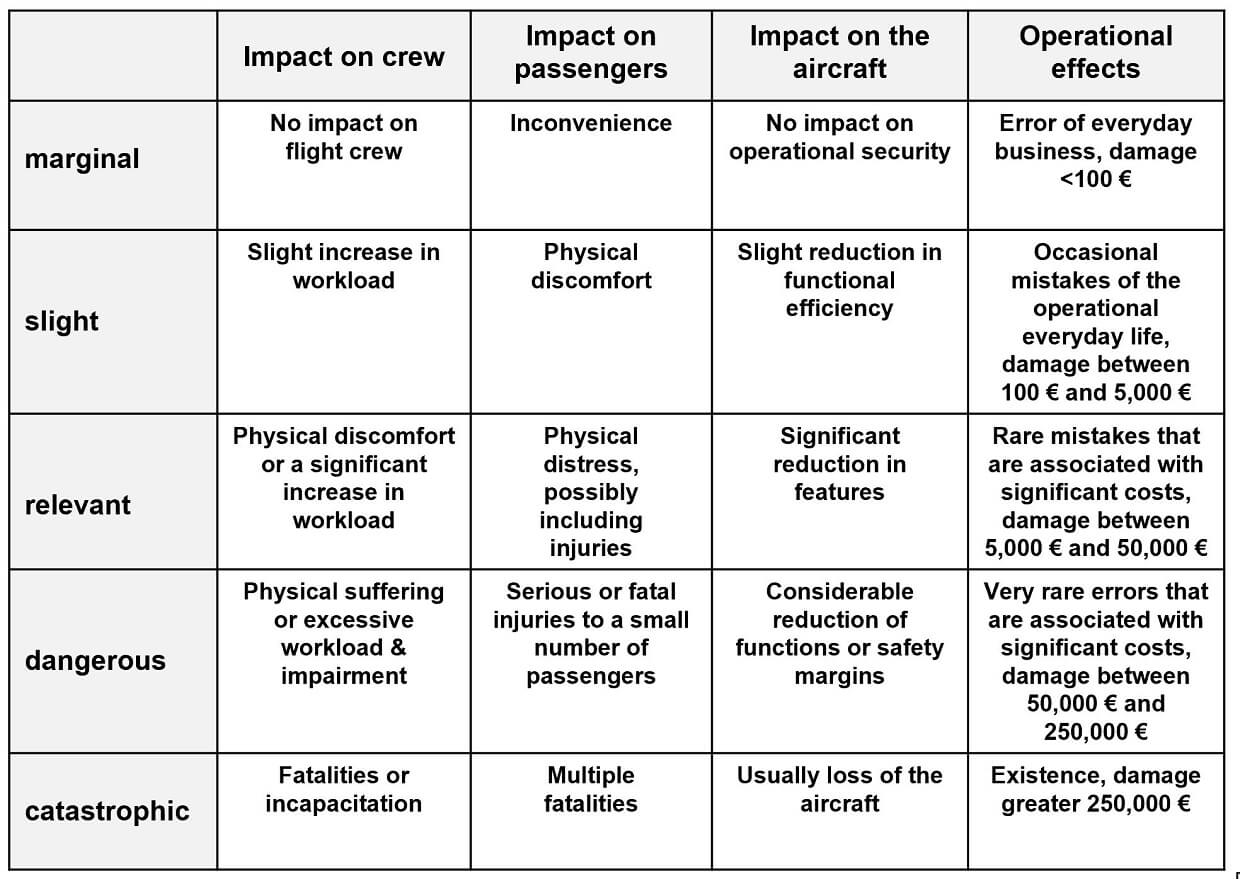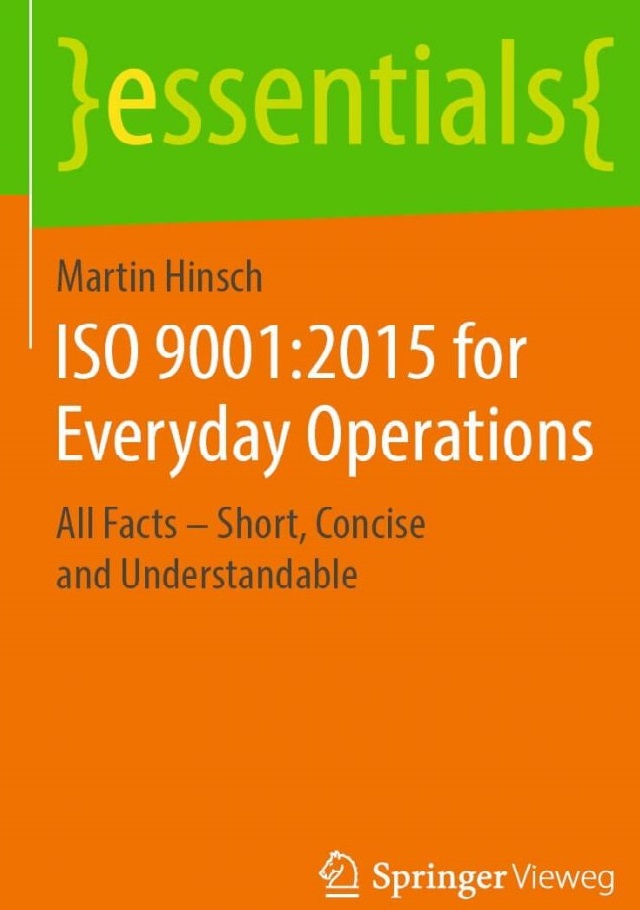Basics of Safety Management
EASA Part 21
Safety management in accordance with EASA Part 21 is the structured examination of safety-relevant risks in aeronautical operations in order to proactively minimize hazards to airworthiness. Safety management is based on the fundamental idea that safety is a management task that must be anchored in the entire organisation and not just distributed among a few people. Safety should be systematically considered in service delivery, involving all employees.
The upcoming expansion in Part 21 is due to ICAO’s efforts to make safety management structures mandatory for aeronautical operations worldwide as well. In 2013, ICAO Annex 19 was published for this purpose. Current details are based on their publication of SMS Industry Standard SM001 Issue A, dated September 17, 2018. EASA has responded by revising the Implementing Rule Initial Airworthiness and issuing a draft, the so-called Notice of Proposed Amendment 2019-05 (A) and (B), NPA 2019-05 for short (A) or (B).
The Safety Management System (SMS) topic for manufacturing and development operations is expected to be included in EASA Part 21G and Part 21J, respectively, in early 2022.
Most changes are made to Sections 21.A.3A, 21.A.139, and the associated Guidance Material or AMCs. For design organizations, it is primarily paragraphs 21.A.3A, 21.A.239, 21.A.243, and 21.A.245. For integration into the existing regulations, EASA has extented the existing quality system in Part 21G, respectivly the Quality Assurance System in Part 21J by a Safety Management and merged it to the Production Management System, respectivly the Design Management System.
Do you already know our Safety Management E-Learning?
- 150 Minutes
- Video animated clips with sound
- Certificate is sent automatically after passing the test
- Saves working time compared to 1-day face-to-face training
- Incl. all requirements of EASA Part 21 & Part 145
The new Implementing Rule leaves no doubt that safety management will in future be on an equal footing with the quality management system. At the same time, however, EASA explicitly points out that the Safety Management System may be combined with other operational management systems such as quality, occupational health and safety and environmental management systems. The idea behind this is that integration avoids duplication of effort and exploits synergies. Safety management in accordance with EASA Part 21 should be aligned with operational needs and the product or service spectrum.
In the future, the revised EASA regulations will require training on safety management and the fundamentals of human factors in development and production as well, both in the company’s own operations and those of its suppliers. We offer solutions via our face-to-face and our video-animated online trainings.
Basics Safety Management
EASA Part 21
The requirements for operational safety must be implemented in a Safety Management System (SMS). Such SMS is a formally anchored operational structure and process concept that is intended to ensure the safety of the products placed on the market. Its task is to identify safety risks and to use risk management to keep them under control or eliminate them wherever possible. The focus is clearly on product risks.
However, to ensure the sustainability of EASA Part 21 safety management in operations, such a system must not only exist on the basis of documented structures, it must above all be applied in daily practice. The decisive factor in this respect is the behavior of all employees, especially managers. This requires education and training on the one hand, and the systematic development of a corporate safety culture on the other.
Organizational framework Safety Management acc. to EASA Part 21
Management Responsibilities: The operational management of an EASA Part 21 production facility or design office must implement and maintain a SMS that meets the individual requirements of the organisation. To do this, the management must:
- Establish a safety policy and safety goals,
- Actively engage subcontractors and partners as part of the SMS,
- Introduction of a safety risk management process,
- Measurement of safety performance,
- Ensure safety-oriented communication,
- Creating a Safety Culture (Just Culture).
Furthermore, the following components have to be anchored for an appropriate organizational framework of a Safety Management according to EASA Part 21.
Safety accountability: To prevent responsibilities from being shifted back and forth between managers or employees, it is important to clearly define the responsibilities and authorities for the safety management system across all hierarchical levels from management to the operational level. The role of a Safety Manager is to be newly established.
Documentation of the SMS structures: The safety structures and specifications must be in accordance with Part 21G 21.A.139 (e) or documented for Part 21J 21.A.239 (e), these primarily include:
- Safety Policy and Safety Goals,
- Description of Safety relevant process structures (or references to relevant documents),
- Description of operational Safety activities as well as a general description of the operating sites,
- Organization chart(s) to clarify operational Safety responsibilities,
- Named Safety Officers and teams, including their operational role,
- Description of internal and external Occurrence Reporting.
However, the documentation of the Safety Management System is not limited to the SMS manual alone. In addition, the safety requirements must be incorporated into existing process descriptions or procedural instructions, as well as into operational checklists, fill-in instructions, manufacturing specifications, etc.
Involvement of subcontractors: Subcontractors must also be involved in the new safety management system. Safety risk management must also be in place for their contribution to value creation. The basic principles are to be anchored in the quality assurance agreement and their compliance and up-to-dateness are to be reviewed periodically.
Continuous System Monitoring and CIP: After implementation, the operational management must assess the SMS at regular intervals with regard to its performance. This task falls to a Safety Review Board, composed of key management personnel. Corrective actions must be instructed and monitored in case of deviations from the established Safety Policy or Safety Objectives. A Safety Action Group should be established for this purpose for operational implementation. The basics can be found in EASA Implementing Rule Initial Airworthiness 21.A.139 (b) (for Part 21G) or 21.A.239 (b) (for Part 21J).

You need support with
Safety Management?
We support you!
Get a non-binding offer at or
+49 (0)40 5131 5291
Operational Safety Management
EASA Part 21
The core of safety management in accordance with EASA Part 21 is the identification, evaluation, control and monitoring of safety-relevant hazards (see also EN 9100 Section 8.1.1). This is a product-related safety risk management that represents a continuous process (PDCA) (Fig.). In operational practice, this is usually re-triggered on a semi-annual to annual basis. For operational safety risk management, the company must set up a steering committee (Safety Action Group), which is made up of management from the first and second levels of the hierarchy. EASA Part 21G defines the framework for production organizations in paragraphs 21.A.139 (c) for manufacturing, respectivly 21.A.239 (c) for design.
Safety Risk Management Process
Hazard identification
At the beginning of the risk management process is the structured identification, collection and sorting “[of] any existing or potential condition that can lead to injury, illness, or death to people; damage to or loss of a system, equipment, or property; or damage to the environment.“(ICAO 2009)
In order to facilitate the identification and structuring of risks, content-oriented risk categories are to be formed in advance. On this basis, the actual inventory of safety-relevant hazards in the product or in the production processes or in their environment is then carried out.
Risk analysis and assessment
After the organisation has identified all safety risks, a process must be set in motion to analyse and evaluate these hazards.
In operational practice, it is helpful to collect and order the safety risks in a risk FMEA and to visualise a risk matrix with three to five risk clusters accordingly
Risk management
After the risks have been identified, analysed and evaluated, the determination of risk management measures takes place. In principle, the following strategies – individually or in a mix – can be considered for risk management:
- Risk avoidance
- reduction
- Risk transfer
- Risk acceptance
Depending on the measure taken, close monitoring may still be necessary.
Safety and risk monitoring
The effectiveness of control measures taken must be monitored systematically, if necessary closely, after implementation. For this, key figures must exist that indicate the status of target achievement. The information required for this can be provided, for example, by operating data, surveys or audit results. If deviations from objectives are measured, countermeasures must be developed, instructed and implemented.
Monitoring should not only focus on the development of the safety-related risks themselves, but also encompass the actual safety management system. For this purpose, the company must have a documented process to control the effectiveness of the SMS and to ensure its continuous improvement as well as compliance with the regulatory safety requirements (compliance monitoring).
Promotion of safety knowledge and safety culture
The formulation of operational safety objectives and the corresponding alignment of organizational structures alone are not sufficient for the sustainable success of safety management in accordance with EASA Part 21. The idea of safety must be anchored in the minds of employees.
In order to carry the safety requirements and the safety culture into the company in an appropriate manner, the company’s own employees must therefore be qualified in safety aspects. To this end, EASA has defined new training requirements. Thus, every employee must have undergone safety training and be familiarized with the basics of human factors.
In addition, it is important that the company has effective communication structures that not only serve to achieve safety objectives, but also support the development of a common safety culture. This can be achieved, for example, by addressing safety-relevant topics in team meetings, circulars or employee newsletters.

Our Books
Do you already know our books on technical aviation management?



